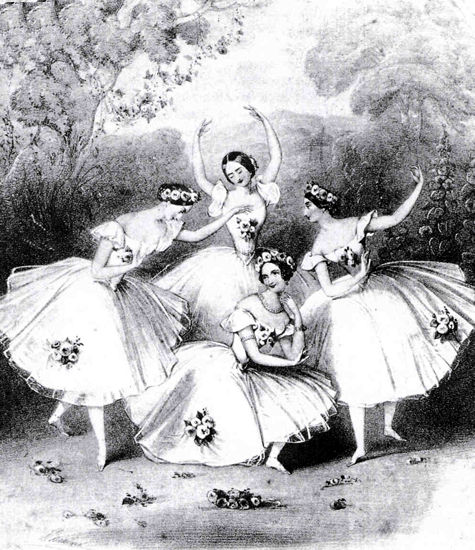Lucile Grahn (1819-1907)

During the nineteenth century Grahn was the most talented ballerina to emerge from Denmark. She showed such talent at the Royal Danish Ballet school that when August Bournonville arrived, he took over her training and later fell in love with her. In 1834, when she was 15, Bournonville took her to Paris. After she visited the Paris Opera she made up her mind to dance there. Her greatest success came in "La Sylphide" choreographed by her mentor. I have told you in a past newsletter that this is the version that we see today.
Grahn was a slight, ethereal teenager, but stubborn as a mule. Her dream of dancing with the Paris Opera caused problems between her and Bournonville. He refused to grant her leave to go to Paris, so she bypassed him and went to Denmark's Princess Wilhelmina, who gave her permisson. When Grahn returned to Denmark her life was made miserable. She claimed that Bournonville was dictatorial, cruel, and possessive. But even with his restrictions, she managed to obtain royal permission to give six performances in Hamburg; she left Denmark in 1839 and never returned.
After four months at the Paris Opera Grahn had the chance to replace the indisposed Fanny Elssler in "La Sylphide." Grahn ethereal air was better suited to the role than Elssler's more earthy approached. This made the older dancer furious. Just before the 1840 season Grahn injured her knee. Her next important engagement was in Russia where she took over Marie Taglioni's roles. Her stay in St. Petersburg was cut short because of the jealousy of the powerful Elena Andreianova-- when will dancers learn there is room for us all?
In 1844, Grahn spent a year in Milan and then went to London. In the next two years her dancing peaked. In 1845 she was invited by Perrot to dance in his Pas de Quatre with Marie Taglioni, Carlotta Grisi, and Fanny Cerrito.
In 1848, Grahn moved to Hamburg and became so fond of Germany that she bought a home in Munich. In 1856, at the age of 37, she married the English tenor, Fredrick Young. After years of happiness her husband was injured in a stage accident which left him confined to a wheelchair for the next 29 years. Grahn immediately began teaching to support them both. She taught at the Munich Hoftheatre and choreographed several ballets and divertissements.
After 30 years, Grahn saw Bournonville again. Time had lifted the cloud of distrust, and they could talk about old friends such as Hans Christian Andersen. Grahn outlived her husband by 23 years, and became a beloved sight, clad in black, on the streets of Munich. She left all her property to that city, and a street was named in her honor.
(First published July 1993)